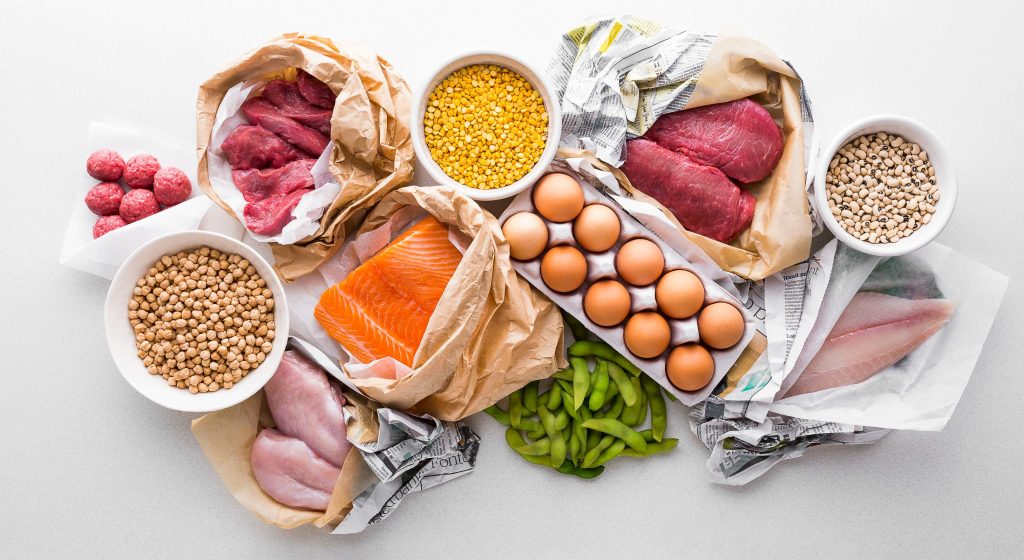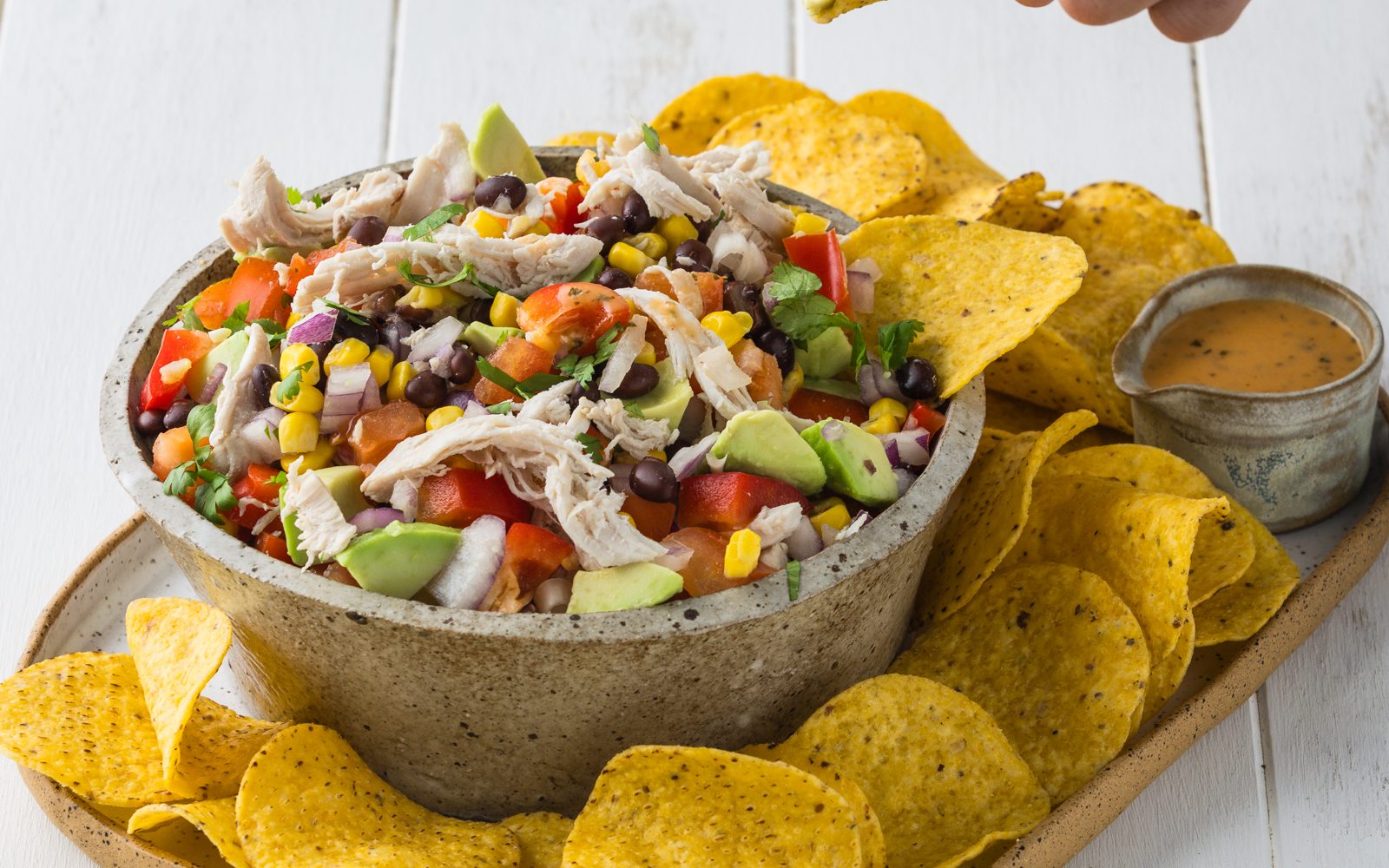
Protein 101
When we think of nutrients, we often think of vitamins, and minerals like vitamin C or iron, (which are essential micronutrients that we need in small amounts to help in thousands of physiological pathways in the body), overlooking that, protein is an important nutrient too. Protein is a macronutrient, meaning it is a nutrient we need in large amounts.
In addition to being a source of calories (for every gram of protein you eat, there are about 4 calories), protein’s primary role in the body is growth and repair. Protein is broken down in digestion into amino acids—building blocks—that help form and repair muscles, hair, nails, skin, bones, organs, neurotransmitters and hormones. Protein is made up of 20 amino acids. While all 20 are important for your health, nine are classified as essential and 11 as non-essential. In nutrition, ‘essential’ means that we cannot produce it ourselves—therefore, it must be provided in the diet.
What’s the deal with plant-based vs. animal proteins?
Animal foods and soybeans provide all nine essential amino acids in sufficient quantities and are classified as complete proteins. Other plant-based protein sources lack one or more essential amino acids and are therefore called incomplete proteins. People who follow a plant-based diet should eat a variety of plant sources of protein every day (e.g. legumes, nuts, seeds, whole grains like quinoa) to get all the essential amino acids (1).
People eating plant-based should also consider the “bioavailability” of plant proteins—this means, how much of the protein can be absorbed and used by our bodies after we eat it. Whilst it is possible to get enough protein through a well-planned plant-based diet, the protein in animal foods such as dairy, meat, fish and eggs has been shown to be more bioavailable to our bodies (2).

But how does protein play a role in weight management?
Turns out, targeting protein whilst reducing your overall calorie (energy) intake can help with weight loss and overall body composition, whilst helping you to feel satisfied and energised. But how? Read on to find out the top three reasons to focus on protein through your weight loss and health journey.
1. Protein keeps you full for longer
Satiety is more than just a physical feeling of fullness after you eat. Satiety is the nonconscious parts of the brain responding and reacting to the food you just ate, signalling a sense of satisfaction. Foods that contain protein (for example, fish, meats, eggs, tofu, legumes) and fibre (vegetables, fruits, nuts, seeds, unprocessed whole grains) have the longest satiety and are also nutrient-dense foods (3).
Once we’ve eaten protein, and it reaches our gut, amino acids stimulate several hormones that tell our brains we are full, and which suppress hunger hormones like ‘Ghrelin’. Further, research proposes that the body may actively monitor protein consumption until our protein requirements are met (4).
Interestingly, when researchers try to explore what causes animals (including humans!) to overeat, some have suggested that it is our hunt for adequate protein. For example, in one study, those who consumed lower amounts of protein in their first meal of the day increased their overall food intake in subsequent meals. In contrast, those who received the recommended amount of protein ate less in following meals (5).
2. Protein protects lean mass
For most, the ultimate goal of weight loss is to decrease fat mass and retain lean muscle mass. Rather than just lowering your overall calorie intake, making sure you’re eating enough protein calories for your age and body weight is a vitally important step in protecting your lean muscle whilst you slowly lose body fat over time (6).
3. Protein provides a small natural calorie deficit
Food contains calories (energy). However, as soon as we eat food, our body breaks it down into the form it can be used or stored protein into amino acids, carbohydrates into glycogen or glucose, and fat into fatty acids.
It takes energy for us to digest food, so some calories are lost in the process of digestion. It is called the Thermogenic Effect of Food (or TEF). Due to TEF, we lose about 2-3% of calories of fats, 6-8% of carbohydrates and 25-30% of proteins. So, for every 100 calories of protein you consume, about 25 are lost to digestion (7,8,9).
This may seem like only a few calories. However, it can be challenging to maintain a calorie deficit consistently. This small natural deficit can make reducing calories more achievable long term and result in more sustainable weight loss.

What are some practical, everyday steps to get enough protein?
Start by working out your recommended daily intake (RDI) of protein. The basic calculation commonly used is multiplying kg of body weight by 0.8g of protein. This amount is established to be a minimum level to avoid deficiency. However, many experts in the field suggest a higher protein diet when trying to lose weight— this could be as much as 1.2–1.6g of protein per kilogram of ideal body weight (11,12,13). For example, an 90kg person aiming to lose weight may have a protein goal of 108-144g per day
Once you’ve decided on your protein goal, distribute it between the number of meals you like to eat, especially focus on the day’s first meal. Try incorporating protein-rich foods such as meat, fish, seafood, eggs, yoghurt, cheese (especially low-fat high protein versions such as cottage cheese), tofu, tempeh, legumes and beans, lentils, and chickpeas. For example, a 100g serving of raw/uncooked chicken breast provides 31g of protein. See how you feel. Some people, such as teenagers, pregnant or breastfeeding women, people with illness, athletes, gym goers, and older adults, require more protein to thrive.
Fresh Start has you covered for dinner with our high protein meals containing more than 40g protein per serve with plenty of fibre-rich veggies. Fresh Start meals are created with Nadia’s ‘nude food’ philosophy of using whole foods to ensure our meals are more nutrient-dense than energy-dense.
Can too much protein be harmful?
As with most things, there can be too much of a good thing and if you eat too much protein from red meat, processed meats and animal products it may add higher amounts of saturated fat to your diet and increase the risk of heart disease and bowel cancer. It’s important to eat protein within the context of an overall healthy diet.
The bottom line:
A key part of a healthy diet is to eat your daily protein requirements, thereby protecting your lean mass and losing body fat. Targeting a specified gram amount of protein in each meal will help you increase the proportion of protein in your diet.
Explore some of our protein packed breakfast and lunch ideas to help you reach your protein goals earlier in the day:
REFERENCES
1. https://nutritionfoundation.org.nz/nutrition-facts/nutrients/protein/
2. Gertjan Schaafsma, The Protein Digestibility–Corrected Amino Acid Score, The Journal of Nutrition, Volume 130, Issue 7, July 2000, Pages 1865S–1867S, https://doi.org/10.1093/jn/130.7.1865S
3. Holt, S.H.A. & Brand-Miller, Jennie & Petocz, Peter & Farmakalidis, E. (1995). A Satiety Index of common foods. European journal of clinical nutrition. 49. 675-90.
4. Morrison CD, Reed SD, Henagan TM. Homeostatic regulation of protein intake: in search of a mechanism. Am J Physiol Regul Integr Comp Physiol. 2012 Apr 15;302(8):R917-28. doi: 10.1152/ajpregu.00609.2011. Epub 2012 Feb 8. PMID: 22319049; PMCID: PMC3330767.
5. Grech, A, Sui, Z, Rangan, A, Simpson, SJ, Coogan, SCP, Raubenheimer, D. Macronutrient (im)balance drives energy intake in an obesogenic food environment: An ecological analysis. Obesity (Silver Spring). 2022; 30( 11): 2156- 2166. doi:10.1002/oby.23578
6. Dylan D. Thomas, Nawfal W. Istfan, Bruce R. Bistrian, Caroline M. Apovian. Protein sparing therapies in acute illness and obesity: a review of George Blackburn’s contributions to nutrition science, Metabolism,
Volume 79, 2018, Pages 83-96, ISSN 0026-0495, https://doi.org/10.1016/j.metabol.2017.11.020.
7. Feinman RD, Fine EJ. “A calorie is a calorie” violates the second law of thermodynamics. Nutr J. 2004 Jul 28;3:9. doi: 10.1186/1475-2891-3-9. PMID: 15282028; PMCID: PMC506782.
https://pubmed.ncbi.nlm.nih.gov/15282028/
8. Eric Jequier, “Pathways to Obesity”, International Journal of Obesity, (2002).
https://pubmed.ncbi.nlm.nih.gov/12174324/
9. Tappy L. Thermic effect of food and sympathetic nervous system activity in humans. Reprod Nutr Dev. 1996;36(4):391-7. DOI: 10.1051/rnd:19960405. PMID: 8878356.
10. Phillips SM, Chevalier S, Leidy HJ. Protein “requirements” beyond the RDA: implications for optimising health. Appl Physiol Nutr Metab. 2016 May;41(5):565-72. doi:10.1139/apnm-2015-0550. Epub 2016 Feb 9. Erratum in: Appl Physiol Nutr Metab. 2022 May;47(5):615. PMID: 26960445.
11. Moon J, Koh G. Clinical Evidence and Mechanisms of High-Protein Diet-Induced Weight Loss. J Obes Metab Syndr. 2020 Sep 30;29(3):166-173. doi: 10.7570/jomes20028. PMID: 32699189; PMCID: PMC7539343.12. Donald K. Layman, Ellen M. Evans, Donna Erickson, Jennifer Seyler, Judy Weber, Deborah Bagshaw, Amy Griel, Tricia Psota, Penny Kris-Etherton, A Moderate-Protein Diet Produces Sustained Weight Loss and Long-Term Changes in Body Composition and Blood Lipids in Obese Adults, The Journal of Nutrition, Volume 139, Issue 3, March 2009, Pages 514–521, https://doi.org/10.3945/jn.108.099440


